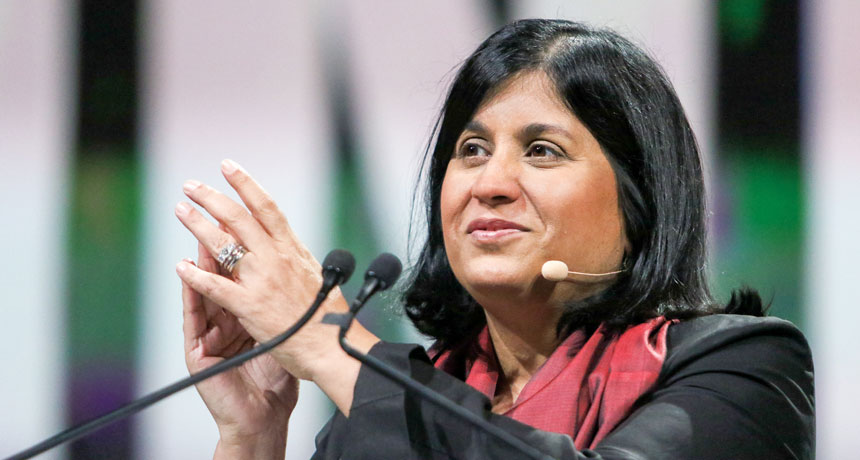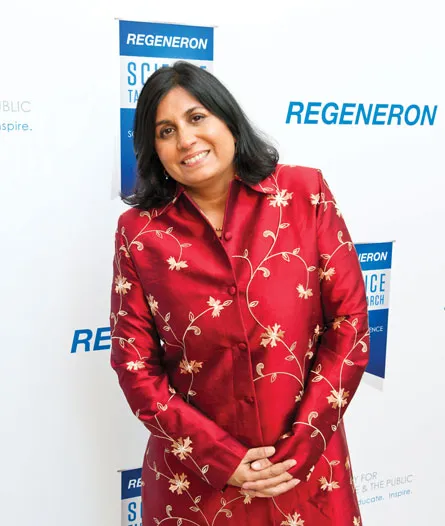Reflecting on two years at the Society: A conversation with Maya Ajmera

It’s hard to believe two years have flown by since I joined Society for Science & the Public as President & CEO and publisher of Science News. When I arrived, the pressure was already on. After 20 extraordinary years with Intel as the title sponsor of the Society’s flagship competition — the Science Talent Search (STS) — we were seeking a new partner.
We have to do more to engage all students with STEM education.
After an amazing response to our STS search, we were able to share great news this past May when Regeneron became just the third sponsor in the nearly 75-year history of STS. By committing $100 million to support the Science Talent Search and other Society programs through 2026, Regeneron — founded by STS alumni George Yancopoulos and Leonard Schleifer — made the largest commitment we’ve ever received from a single organization. Beyond sponsoring STS, Regeneron’s investment in outreach and equity — $30 million over 10 years — will allow the Society to do so much more to engage all students in this country with STEM education.
Regeneron’s investment will help us greatly expand a new program we started shortly after I joined the Society — Science News in High Schools. The program not only provides a great resource to students and teachers, but also addresses the second biggest challenge of my tenure: The fact that, like all media companies and newspapers, we were learning that there’s no secret sauce for addressing the radical shifts in publishing business models impacting Science News. But Science News in High Schools is one innovative approach that’s working.
The program provides 10 copies of Science News to a high school’s science department, free digital access to sciencenews.org (including our extensive archive) for all students in the sponsored school and an educator guide to help shape classroom experiences around our exceptional science content. In a survey following the pilot program, teachers called Science News in High Schools a valuable resource and expressed huge appreciation for the program and our early sponsors. Now Regeneron has carved out $2 million per year for the next 10 years to grow the program, allowing up to 4,000 more high schools to participate. My dream is that Science News will reach every high school in the country so that new generations of students are inspired by science.
The reason Science News in High Schools is so powerful is the same reason that so many of you have been reading the magazine for years: our journalists. Science News, led by Eva Emerson, is home to an extraordinary and creative group. I’m proud to say we’re one of the few science newsrooms left in the country, which makes it all the more important for Science News to survive. We need to continue to provide accurate, timely and important scientific stories so crucial to our future, our children’s future, and to the future of our democracy.
That future starts with kids discovering their interest in science. And that’s why I’m so pleased that Science News for Students — written for students in middle school on up and packed with great features for teachers and students — is now its own digital product. Take a look at sciencenewsforstudents.org. It’s a gorgeous site that we hope will get millions of students reading about science.
With the help of many generous funders, the Society has been able to launch and grow several other important new programs. The Advocate Grant Program provides support and a grant to mentors of underserved students doing STEM research. Advocates help students learn about and complete applications for science research competitions, allowing them to gain the benefits of participating in local and national events.
We’re one of the few science newsrooms left in the country … we have to survive.
The Research Teachers Conference brings together 200 research teachers from across the country for an all-expenses-paid weekend of professional development in Washington, D.C. Experienced research teachers lead sessions on topics such as how to guide students writing a research report, increase the participation of underserved students in research, and recruit scientist mentors to support student work.
STEM Action Grants allow the Society to support innovative nonprofit organizations such as ProjectCSGirls, which was founded by 2015 STS alumna Pooja Chandrashekar. We look forward to supporting social entrepreneurs who provide STEM opportunities to young people.
And STEM Research Grants enable teachers to expand and enhance their independent research programs for students by providing one-time funding for special purchases or other needs, such as lab equipment. Special consideration is given to teachers working with underserved students.
These students are the future of our STEM talent pipeline in the United States and the world.
 In addition to STS, the Society’s other competitions made news as well. Last year, the Broadcom Foundation renewed its sponsorship of our middle school science competition, the Broadcom MASTERS, for six more years with a significantly higher budget. Broadcom MASTERS students are the future of the STEM talent pipeline in the United States and the world. We’re starting to see the fruits of Broadcom MASTERS in our other competitions as alumni compete in the Intel International Science and Engineering Fair (Intel ISEF) and STS. It was thrilling to meet this year’s Broadcom MASTERS International delegation at Intel ISEF.
In addition to STS, the Society’s other competitions made news as well. Last year, the Broadcom Foundation renewed its sponsorship of our middle school science competition, the Broadcom MASTERS, for six more years with a significantly higher budget. Broadcom MASTERS students are the future of the STEM talent pipeline in the United States and the world. We’re starting to see the fruits of Broadcom MASTERS in our other competitions as alumni compete in the Intel International Science and Engineering Fair (Intel ISEF) and STS. It was thrilling to meet this year’s Broadcom MASTERS International delegation at Intel ISEF.
Intel ISEF 2016 was incredible. Over an amazing five days in Phoenix, more than 1,750 finalists from more than 77 countries, regions and territories competed for more than $4 million in awards. In 2017 we’ll be introducing a new program — the Intel ISEF Commons — which will connect colleges and universities with Intel ISEF competitors, the next generation of talent in STEM.
Together, we’ve achieved so much over the last two years and we couldn’t have done it without you — Science News subscribers. You care so deeply that when we asked you to go above and beyond to become members of or donors to the Society, you responded with enthusiasm and generosity. We owe you an enormous debt of gratitude and we hope you will be part of our work for years to come. We’ve heard from many of you that reading Science News inspired you to become an engineer or a scientist. We want the next generation of readers to feel the same way.
—Maya Ajmera